#Expert Concept Elaboration
Explore tagged Tumblr posts
Text
What is Concept Elaboration? Concept Elaboration Services
Concept Elaboration and Understanding the Importance of Clear Communication The intricacies of language often present challenges, especially when conveying complex ideas across different cultures. Concept Elaboration, a vital process in language services, ensures clear and comprehensive communication. This article delves into the origins, implementation, and significance of Concept Elaboration,…

View On WordPress
#Accurate translation services#Clear and Precise Translations#Comprehensive Localization#Cross-Cultural Communication#Culturally Relevant Adaptations#Detailed Concept Explanation#Effective Global Messaging#Expert Concept Elaboration#Expert Linguistic Analysis#High-Quality Interpretation#Multilingual Communication Services#Nuanced Concept Translation#Professional Language Solutions#Seamless International Communication.#Specialized Industry Expertise#Tailored Language Solutions
0 notes
Text
so id say my tumblr network (as in, the people who tend to see/interact with my posts) is pretty mathy. i wanted to see how people interact w math and how they like to learn about it :) (and: maybe do something with that on my blog!!! wouldnt that be fun)
polls have a limited amount of characters i can add per option, so ill clarify some concepts here:
informal education is learning via a coordinated effort by an instance/expert outside of school system (e.g. voluntary lectures, social media posts, museum visits, youtube videos or similar). by informal i dont mean "its school but the teacher is chill" or independent research!!
formal education is learning through a school system (usually mandatory/with a teacher or professor present)
i refer to any education you do without making use of coordinated programmes as independent research, so that would be just you picking up an advanced math book to educate yourself, or perhaps scanning wikipedia, or emailing math profs with questions
when i talk about reading math in a general context, i mean that the material discusses math for a broad audience, so it doesnt talk about super niche specific mathematical concepts, and doesn't contain any complicated formulas/proofs/math speech
please do elaborate in the tags!!!
#polls#mathposting#im pretty curious#mostly bc im doing science communication now#and i want my blog to be my own fun and cool space for math#but also a place where i can practise effective scicom lmao
146 notes
·
View notes
Note
what is it like to be kind of popular/getting people interested in your own ideas and not fan art?
I don't think I'm popular *looks behind my back fearfully* 😨
Here's the thing. A lot of people post things and just expect people to find them and interact with them. To some people it works. But a lot of the time there's no way for people to even find your stuff or engage with it.
A lot of people go into fandom tags to look for art and writing, but not a lot of people just scroll the "oc" or "art" or "writing" tags aimlessly.
I'm not like. A social media expert 😼 or whatever. I don't know anything about anything ♥️ I literally just do whatever weurd things i want and that's it
Here's some things I can advise:
If you have ocs.... Please feel free to actually talk about them in detail, share your thoughts on them in detail, write actual info and profiles on them. Don't be shy to do this bc there's no way for someone to engage with your ocs if they don't really understand who you're talking about except the names 😭... Feel free to like link their info in your pinned or their toyhouse profiles or whatever... !!!! A lot of the times I follow someone and they ask to engage with their ocs, and I want to, but I literally just don't understand who they're taking about... Or I see someone talking about their ocs in very vague terms but I can't actually find who they're talking about.... (Not that you have to do this do whatever you want ... I'm not the boss of you ♥️ it's just something id like to see) And also don't be shy to actually remind people who you're talking about bc people who haven't been following you for a long time won't know. I think this is simpler for me because my concepts/characters are very basic/shallow and easy to understand. Taur who is a bee, taur who is a bath, etc... Is Inherently understandable and doesn't have any deep lore
👆 this applies to everything in general not just ocs. Talk about art. Talk about your own art. Talk about what you love in the art of others. Talk about your plans and concepts and ideas. Talk about your projects. Share with the world 🌍 🌍 🌍
Don't be shy to talk about your things. I think some people are anxious about seeing people unfollowing them. I personally use xkit to hide my followers on pc and actively avoid looking at my follower count on mobile... Because idgaf ♥️. If someone doesn't like what I post they're Nothing to me. I post about taurs and weird things basically every day. What do I have to lose? My dignity as a Tumblr blogger? Genuinely like just share whatever thoughts or concepts or doodles or drawings you want without being like "aww nobody wants to see this". Honestly I also do this because I don't have friends to talk about concepts and stuff with so your mileage may vary. Maybe you don't want to post. Maybe you worldbuild with your friends. Then maybe you can share the results of that worldbuilding and thoughts, that's good too.
Self reblog your stuff 😭 even old stuff. Self reblog your stuff and then elaborate on it further with your thoughts. Dig up old concepts and do things with them. Its okay to do this. Not everyone sees your stuff when you first post it... !
Actually engage with others. Others are more likely to see you and engage with you when you do the same to them. If you never interact with anyone else's art why would others interact with yours. And unfortunately posting stuff and expecting people to just stumble upon it is not a very good strategy...
79 notes
·
View notes
Note
Hello! You said something in your tags in a reblog on my post, and I wanted to hear more about it (but don't really know how to respond to something people say in tags 😭).
You referred to the concept of a Feminized Jewish Man. I don't know much about that trope - though one person told me about an antisemitic myth that cis Jewish men mestruate, if that's related!
So if you're willing, I'd love to hear you elaborate on that, if not, no worries and have a good day!
They were correct - that was (and is) a very common antisemitic trope. I don't want to include it here, but some old Nazi-era propaganda depicted jewish men with breasts in addition to the other common racist tropes of the era, for example. It was (and, again, is) common for people to depict jewish men as being feminine in mind, body, and spirit.
I do want to elaborate by saying that I am by no means an expert on this, and much of my knowledge comes from being in jewish communities and direct experiences. However, there is still a prominent practice of portraying jewish men in demeaning ways that rely on the idea of femininity being degrading and dehumanizing all the while being intrinsic to the Jewish Man. Nowadays, it is often... more subtle than depicting a jewish man with breasts, but it still absolutely exists
This is honestly why I dislike when people portray trans experience as being inherently incomprehensible to cis people. When jewish men are feminized, it is done with the same level hatred that I have experienced for being trans. I've found that many jewish spaces I have been in have more sensitive about gender specifically (in general) for many reasons. There are way too many potential reasons to list, but I think it could potentially stem from the antisemitic, racist ways that antisemites will weaponize femininity and masculinity against whomever it will hurt most.
#ask#jumblr#jewish politics#antisemitism tw#i hope this answered this - i wanted to keep it a bit shorter so it's comprehensible and i also have class in five minutes LOL
60 notes
·
View notes
Text
Exploring The Complexities of The Lamb and Narinder’s Relationship
Long post warningsgsgsgsgsh!!!!!! 🥺🥺

For those of you who want a quick rundown of what the AU’s about, check out the link at the bottom of the post.
Warning: Mentions of Cannibalism, Unhealthy & Obsessive Relationships, and Spoilers for The Art of Acquiring Devotion
Now, firstly, I’ll have to give my thanks to @nimbudcat for providing me with ideas as to how the relationship would function and opening the gateway for me to fully explore all the nooks and crannies of their romance.
I’m no expert on the deep complexities of toxic relationships, so I don’t have the courage to fully label the Lamb and Narinder’s love as ‘toxic’, but I know damn well that it’s not a normal love at all. Let’s think—what is a normal, healthy relationship composed of? Trust, of course. Mutual love and trust, absolute honesty... Those are the most basic building blocks of a healthy relationship. In this AU, for Narinder and Lamb, those concepts are extremely warped. They have all of those components in their relationship, but it’s so twisted that it’s difficult for me to define their romance as either healthy or unhealthy.
Narinder and Lamb trust each other, and it runs so deep that the best descriptor for that trust is pure devotion. They trust each other with their lives. This may not make sense since they are immortals, but think about it—the cannibalism that they inflict upon one another results in death for the two, each and every time, and they trust only one another for their resurrections. They allow the most vulnerable parts of themselves only to one another, and this is so incredibly meaningful because of all the aspects of their pasts. They trust themselves of course to always only tell the truth to each other, and the love that they share is simply reverent.
Now, let me elaborate on why all the things I expanded on above mean so much. Let’s start with the Lamb. I as I said in my previous post, the Lamb’s past for this AU is derived from my fanfic. We don’t know much at all about pre-sacrifice Lamb in-game, so I took the liberties to expand on their world myself. I’ll allow some passages from my fanfic to speak for itself:
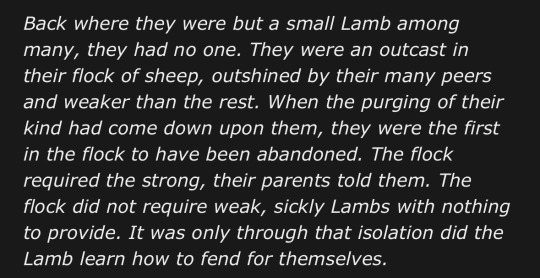


It was through these traumatic experiences that the Lamb became hungry at the thought of companionship. No, the Lamb doesn’t just want some of Narinder’s Big Fluffy Gyatt™. As I’ve depicted in my other artworks, in this AU the Lamb considers Narinder as their savior, their one and only salvation, and perhaps the only person that has ever cared about them. And this is where things start to get murky—it’s because of this that the Lamb is so incredibly attached to Narinder and is absolutely insane about him.

The Lamb isn’t just attached, actually. They’re obsessed with Narinder. So obsessed that they develop a panic if they don’t hear his voice after more than half an hour. So obsessed that they begin to see any and all followers that interact with him as an enemy. This is also why I hesitate to consider this as toxic, because, see, Narinder likes it.
Moving on to Narinder’s part of the AU, it’s important to understand that, although he pretty much brought it to himself because of his high and mighty behavior, he was also quite isolated in his earlier years.

For Narinder’s side, he firmly believed himself to always be in the right. Think of it as a mad scientist whose ideas are way ahead of his generation. He had innovative thoughts and concepts in mind in the duration of his reign. He’d been supplemented by the knowledge that Shamura had provided him with, and that caused him to possess the mind of a radical inventor. Unfortunately, his ideas were less than desirable for the rest of his siblings and his own followers, so little by little the worship he received dwindled. Narinder was frustrated by this—why couldn’t anyone see the genius that he had to offer? Initially he had good intentions in mind, but he grew a tyrannical mind and eventually decided that the only way for the world to see his wonders is to force it beneath his feet.
Eons of imprisonment provided no aid for his mind. What once was a head full of wonders that could potentially change the world for the better became a twisted and cruel version of itself. Violence and revenge plagued his mind, and it became his one and only obsession. So, when the Lamb came to him, he relished in the worship they had to offer.

Their devotion for one another is purely mutual, but at the same time fully in their own self-interests. The Lamb is devoted to Narinder because Narinder is all that they care about in their mind, and they desperately require Narinder for them to continue living on. As for Narinder, he had never acquired such a passionate follower before, and he grew an addiction for the love that they have to offer. I don’t know if it’s a good thing or not.
They are incredibly violent for one another because that’s all they know. They don’t understand what it’s like to have a normal relationship. They cling to one another, kill for one another, and eat one another because they need each other so badly. The cannibalism is an expression of their eager desire to simply blend into one another because that’s just how much they want the other.
They know it’s wrong. They hate that it’s wrong. They hate each other for making each other feel so wrong and so crazy. But they so, so want it to be right.
(Okay sorry for the bad essay lmao adios)
#Compulsion of Flesh AU#cw unhealthy relationship#cw cannibalism#cotl#cult of the lamb#narilamb#narinder x lamb#cotl fanfic
141 notes
·
View notes
Text
Saint Just's speech of November 13 analyzed in a few words by the famous lawyer Jacques Vergès

Jacques Vergès ( 1925-2013)
In a YouTube video, the famous lawyer Jacques Vergès is interviewed on an Algerian TV show. Vergès is well-known in Algeria because he was the lawyer for many members of the FLN (National Liberation Front) and, above all, fervently supported the cause of the Algerian revolutionaries. He not only defended them but also married one of the most famous Algerian revolutionaries, Djamila Bouhired. At the time, defending FLN members during the Algerian War was a huge risk. Lawyers could be assassinated by extremists, like Pierre Popie, who was killed by the OAS (Secret Army Organization), or Maître Ould Aoudia, who was allegedly assassinated by the French secret services, as claimed by Raymond Muelle (this is also mentioned in the video, among other things).
Where it becomes especially interesting for those of us passionate about the French Revolution (or experts, considering some Tumblr users ^^) is when, at one point in the video, Jacques Vergès is shown two images: one of Saint-Just and another of Louis XVI (specifically at 1:28:12). Vergès explains that Saint-Just’s speech to the Convention on November 13, 1792, is, in his view, an "indictment of rupture" (this holds significant meaning for Vergès, who excelled in defenses of rupture, having achieved the remarkable feat of never having a client executed, particularly in the highly rigged trials of colonial justice during the Algerian Revolution). This is rare, as prosecutors (or at least those leading the accusation at the time) typically invoked the law. Vergès then elaborates (I’ll quote him directly from here on): "In the king's trial, some argue that it was impossible to try Louis XVI because the monarch had immunity tied to his functions, while others argue that the moment Louis XVI betrayed that immunity, it no longer applied."
Vergès concludes by referencing Saint-Just’s speech: "One day, people will be astonished that in the 18th century, we were less advanced than in Caesar's time—there, the tyrant was slain in the Senate itself, with no other formality than twenty-three dagger blows, and no other law than Rome's freedom."
The video continues a bit further on the topic of Saint-Just. Vergès finishes by saying that Saint-Just serves as a fantastic example for youth, ending with the revolutionary’s quote: "I despise this dust that makes me up and that speaks to you; they may persecute it and kill this dust! But I defy anyone to take from me this independent life I have created for myself in the ages and in the heavens."
What truly intrigued me was the legal perspective of Vergès, a specialist in defenses of rupture, on Saint-Just’s speech—particularly the concept of the "indictment of rupture."
Here is the link to the video (but it is in French and there are no subtitles) as a reminder the part that interests us, that is to say the evocation of Saint-Just, is at 1:28:12
Here is the link to the video (but it's in French and there are no subtitles). Just as a reminder, the part that interests us—the mention of Saint-Just—is at 1:28:12: https://www.youtube.com/watch?v=pZsK9975YoA&ab_channel=allkhadra.
33 notes
·
View notes
Text
Hera & Frealaf's Clothing
@from-dark-dunharrow (since you asked about it :D)
Please note that I am not an expert on anything related to fashion, much less historical fashion, and this all comes from my vague and general knowledge on the subject :D. This rant will go over spoilers since I'm talking about their outfits throughout the whole movie so, be warned.
SO! Hera's tunic and riding boots (? I'm referring to her thigh highs but I can't tell if those are boots or supposed to be like chapps) are pretty close to white in color, alongside the gloves she wears in one scene, and of course the frankly iconic wedding dress. Her pants and the trim on her tunic range from light-mid brown (tunic) to dark brown / black (pants), with golden accents for things like the buttons(?) on her shoulder pieces and her hair ornaments (ex. the crown at the end).
The one major exception to Hera's color scheme is the green dress she wears early on in the movie, a color that seems to be a more traditional color for Rhorric people to wear (considering it's use in the background of both WotR and LotR, especially for cloaks), with the dress itself being one that is used for a very formal occasion (the summoning of the Lords of Rohan). One thing I find interesting about this dress, alongside it being a very formal dress (that honestly feels a tiny bit off in terms of Rhorric formal dress, but that's due to comparing it to Eowyns' dresses in the movies), is that it features golden accessories that are far more elaborate. The dress looks expensive, something that a princess would wear, compared to the more adventure-y look that Hera seems to prefer. She dons the proper attire of a princess around the other lords during a moment in the movie where the Lords are talking about her as if she doesn't exist, almost as if, by wearing something not in her usual color scheme, she is hiding a large part of who she is beneath the title and expectations of "Princess".
This could also be me looking too deeply into the dress, but some thoughts on it (briefly, as I am trying to focus on the white & dark accents color scheme for this).
Frealaf on the other hand, his very first outfit in partially hidden underneath his dark (blueish black) cloak, and unlike Hera's, his color scheme is almost reversed initially. His tunic has a large chunk of white, but the sides and the middle of the tunic are a much darker color (can't tell if it's supposed to be dark grey, blue, or green from my own pictures). He also has very noticeable golden trim and decorations on his outfit -- similar to the green dress, his clothing for the meeting of Lords looks expensive, something befitting the nephew of the King and a Lord in his own right.
The next outfit we see him in is much closer to Hera's, with the tunic being predominately white with dark trim in the middle & dark pants (like Hera's), though he also has the addition of black and gold armor, alongside his blueish black cloak still.
His final outfit (excluding Helms' armor) is the coronation fit, a white tunic underneath the formal, royal green cape with gold, red, and blue accents that seem to be traditional colors of Rohan. It's an outfit that is laden with ornamentation and rich, vibrant colors, in sharp contrast to Hera's far more plain clothing, aside from her vibrant blue cloak, that remains in her usual color scheme of white / cream with dark trim.
Before I continue, I'd like to point out that green is also a significant color to both of these characters, and I have thoughts on this as well, which I might talk about after the next section, or might move to its' own post.
Also, one last side note, Hera's color scheme is similar to that of the Great Eagle she tries to befriend in the film and I don't honestly much in the way of deep thoughts on that - I just think it's a neat detail (and maybe showcases Hera's relationship with the concept of her own freedom).
Now, I have a couple thoughts on the significance of white in their outfits.
White is often used as a symbol of purity (especially in the religious sense), which could be used to showcase Hera's youth and inexperience with the situation that she is thrust into (it could also be why her meeting dress is Green, as that is something that she could be very familiar with attending due to it being a regular thing for her family). This could also be part of why white dominates her color scheme, whereas it, while still being a major color, never is the true Main color of Frealafs outfits / why it's always heavily accented with darker / richer colors or under a cloak (being that he's a lord in his own right, he probably does have more experience in battle than Hera)
White is often used as a color related to life (I'm aware its' also used to symbolize death in many places, which also connects here). Hera and Frealaf are the two members of the main cast that are still by the end of the film, so by having white in their outfits when Wulf, Helm, and by extension Haleth and Hama, don't have much if any white present, might be a non verbal way to communicate that These Two Will Live. However, given that white can be associated with death as well, I think it also tells the audience something along the lines of "These two will survive this, but they will both experience death intimately, including potential death of an aspect of themself / who they were" with this being Hera experiencing the death of her family and her people firsthand, whereas Frealaf arguably experiences a sort of "death of the self" where he becomes the last heir to the throne of Rohan after his uncle and cousins all die. However, I'd argue that his very first outfit partially mimicking his coronation outfit is also a non verbal sign that this was always his role, to be a Lord and a Leader of his people, even before he became the king (seriously the main difference between his first and last outfit is the lack of black in the coronation outfit and the more elaborate adornment of the cape and the trim in the coronation outfit - there's a lot more gold for one)
Now one thing that's also important to point out is that, keeping historical clothing in mind, white clothing would have been generally expensive and, in my opinion, very impractical for people who actively / frequently ride horses. White clothing would get dirty very quickly, and in general, I think it'd be weird to wear white clothing while actively riding, so I think it'd be more likely that their clothing wouldn't be true, pure white, but probably would be more like a cream or light grey, the sort of colors undyed wool & linen (or sun bleached) linen sometimes become. This could also play into the general use of their clothing, they would have the money and materials that could allow them to have either actual white clothing (as impractical as that could be for them as Rohirrim), but it would also make sense for them to use undyed clothing as part of their outfits since that would arguably be more practical, especially for riding outfits that weren't primarily darkly colored.
Side note, this is also why I think it's important that we never see Eowyn where her white dresses while being "active" in the sense that we see them when she is waiting in Edoras while the Three Hunters arrive, when she is recovering from the Black Death, and in her Wedding dress / dress she wears during Aragorns coronation in RotK. Her white dresses and even her title, The White Lady of Rohan, have their own connotations that I think partially could tie in with #2 on this list
4) The use of brown in Hera's outfits compared to the use of black in Frealafs' outfits also strikes me as important. For instance, wool can be brown in color naturally, without any dyes, whereas black was generally an expensive fabric that only the weather or men or religion wore. Brown, being an earthly tone, also tends to associate characters with being grounded or stable / dependable (which I believe that Hera shows over the course of the movie in different ways, including her resourcefulness for taking care of problems, such as not fighting the Mumakhils' head on but using her environment / tower defense weapons for). Interestingly, dark brown (the color of her pants and the outer most trim on her tunic) could actually be an expensive color to make - which to me makes a fun duality of the colors in her outfit, they could all be achieved through natural means, but the dark brown and pure white are more expensive, a non verbal showcase of her station within Rohan. Black, on the other hand, is a more somber color, generally speaking, but it could also be associated with humility (hence a connection to religious and monastic lifestyle), which I'd argue Frealaf shows plenty of in the movie (gracefully accepting his banishment from his uncle while still being loyal to him, for instance). And again, black was expensive to make, so Frealaf wearing both white and black really shows that our boy was doing well for himself financially.
5) Onto Hera's wedding dress. The dress being eaten by moths and ragged does it's own work in nonverbal storytelling, but I think the best part of it all is that the sparkly white dress is in ruins. Hera does not want to marry anyone, and while she in experienced in some things (something that she kind of admits to when she pleads with Helm to come inside the gate and lead their people), she does not have the same sort of youth she had in the beginning of the movie (with her finely tailored and well kept clothes). She has grown and matured, no longer this potential pinnacle of royal purity, but a woman who has been worn down by the deaths of her family, the Fell Winter, and the siege of her people in the Hornburg. And yet, she still holds true to her ideals, while her innocence may have died, she remains a woman of purity, not just due to remaining unmarried, but due to remaining true to herself even in the face of such hardships. It was also like, definitely psychological warfare against Wulf, she knew the dress would provoke him, and I absolutely love that she used his own obsessions against him like that.
6) Her last outfit keeps her firmly in her normal colors, which I think once against shows that while part of her may have died during the Fell Winter as she grew more experienced in life, she still remains true to herself, and she lived when all the odds were against her. The biggest difference is that her blue cloak returns (she had it during the first encounter with the mumakhil, but during the siege her cloak was a darker green). I think the biggest thing about the blue cloak returning is that blue is often associated with serenity, calmness, wisdom, and the sky / ocean depending on the shade (which have their own connotations that I'm not about to get into). Hera has grown as a character, she was wise to pay heed to the mumakhil in her lands, and though her wisdom was not listened to, she grew wiser after the Fell Winter. She even feels calmer at the end of the movie, like she's found her own type of peace even after the tragedy she had to endure, and she feels sure and comfortable with her own skills and in herself in general. I think this is something that Frealaf and Olwyn both would have recognized as well.
7) Frealaf's coronation outfit puts the white tunic once again under a cloak. This time, I don't think the white represents purity per se, I think it hold more to the association of light. He was the known / recognized savior of Helms' Deep, and with his ascension to the throne after the Fell Winter, I think the people of Rohan could have seen him as a literal symbol of a brighter future / new beginning for them all, especially combined with the vibrant, rich green of his cloak. Two colors that can be used to symbolize growth put together, and combined with the elaborate golden decorations and the red and blue accents, Frealaf's coronation fit feels (to me) like it is practically announcing a New Dawn / New Beginning / Time of Healing for Rohan and her people with his ascension to the throne and the end of the Fell Winter.
In general, I think it's really fitting that Frealaf and Hera have similar color schemes, in part due to them being somewhat similar in personality (calm and reliable royals, resourceful, loyal) and role in their story (being true to themselves and the saviors of their people). However, I really like that the differences in color and the ways in which color is used in their outfits also does a lot of nonverbal storytelling, which I personally really enjoy (even if I am like, completely way off base / overthinking this lol).
#boo talks#it's midnight so i apologize for the rambliness of this and the potential lack of coherence#it's been a while since I've done any sort of analysis tbh#i have been meaning to get back to it but my skills in writing analysis have definitely rusted a bit (oops)#anywho. war of the rohirrim good and i spent way arguably too much time thinking about this#war of the rohirrim#tolkien#long post#media analysis#(sort of? technically)
15 notes
·
View notes
Note
Just recently found your blog and i love it!!! do have any theories for vanitas' original name? My guess is Abraham, for all it doesn't really fit him, after Abraham van hellsing, who is both a doctor and vampire expert, which I think matches mochijuns naming conventions. Doesn't hurt that it matches with Noe (noah) religiously.
Thank you!! Welcome to the party ;D
Traditionally, I've always said I don't have any strong theories on Vanitas's name—at least none that I actually expect to come true. I think(?) I've talked about this before, but that's not really the kind of theorizing I do? Since right now any name theory is wild guessing and speculation, not elaborating from the text.
That said, I do now have one pet theory that I'm partial to (one I didn't have the last time someone asked me this). I don't actually think this is going to be the case in canon, but for now, I really enjoy the concept of Vanitas's real name being Byron. This is mostly because I think it would be funny, but there are some actual connections too.
Long context short, Lord Byron wrote an unfinished draft of what would have been the first modern vampire story, and then his personal doctor (John William Polidori) took the same idea and fleshed it out into The Vampyre—the actual generally recognized first modern vampire story. But! Polidori's version of the vampire (the version that established a lot of our vampire tropes) was partly inspired by Byron himself. So Byron is sort of this almost-but-not-quite vampire author, writing but also inspiring the tropes of vampirism, which reflects interestingly on Vanitas's relationship to actual vampirism. He's not a vampire, but he's much closer to one than any other human, and in demeanor, he acts more stereotypically vampiric than Noé and many other vampire characters.
Also, Byron is the namesake of the Byronic hero, which Vanitas is a perfect example of. He's brooding, cynical, arrogant, and intelligent, but despite his gloom and self-destructiveness, he has a sort of lonely magnetism about him. Once again, the concept of the Byronic hero is inspired by/named after both Byron himself and the characters he wrote.
As I said, I don't think I'm going to be right about this, as there's a million other theories that could fit just as well, but in the meantime, the concept does tickle me. Polidori's Byron-based vampire even has an especially strong connection to the moon :D.
Anyway, I really like your theory as well. I've noted before that it's interesting that there's no Van Hellsing reference in VnC (or any direct Dracula references at all, save poor dead Mina). It's almost surprising given Dracula is the iconic vampire story. I never even considered that there could be a Dracula reference hidden right there in Vani and waiting to be discovered, but it does make sense. The doctor/vampire expert connection is really fun and fitting! Though I'm afraid I don't know enough about the biblical Abraham to say anything interesting about that aspect beyond what you pointed out there.
#look mom I finally have my very own Vanitas name theory! I'm finally a real theorist!#(lmao)#thanks for the ask!#ask#anon#vnc#vanitas no carte#the case study of vanitas#theory#comparison#vanitas my beloved
45 notes
·
View notes
Note
totally valid, i like looking at your works sometimes, i can tell they're very thoughtful! i like the fact you tend not to leave things unanswered unless it's a great question, demonstrated by the fact you have a height reference tag LMAO, i've wondering if there's anything in kcu or ds that you've never said about them before, even just the most fandom facts character-oriented or not! or if not, is there any scrapped concepts for eithier that you decided not to introduce?
heck! there's probably so much. I have so many docs sitting around about everything I've made, some having collected more dust than others. I can give you some fun facts about various things I've made. I don't remember which ones have been mentioned or not, so I'll try to find really specific things.
ink was going to be the literal son of satan in the old version of fatal flaws exclusively for the meme
kevin the chicken appeared in the bizarre saga as a different godly talking chicken character before dreamswap
there's a lot of stuff I haven't shared about the kcu because it's unfinished and I'd like to complete it when the dangan vibe comes back, but I gave byakuya a relative named tony t. togami who works at the future foundation and he's absolutely terrible (in a good way). there is also a character named the alpha roomba, but I will not elaborate at this time
the kcu is an honorary video game, because there's a roomba racing minigame and one of the expert mode challenges is kaito, who is always slightly faster than you
with greyscale's art style, I was planning on adding more and more colors in every chapter as they befriended more people, while xaki stayed more monochrome until their heart was opened in the end. it was a cool idea on paper, but it ate through my art supplies and nowadays I would prefer the art being easy to manage over the metaphor.
have I ever mentioned that I occasionally imagine ibvs as a beat 'em up game with crappy ds graphics
the evil sans squad was going to exist in ibvs (back when I was first coming up with ideas for it, like a long time ago) until I realized that they had no reason to be in the story besides utmv points and also completely undermined nevin and chris's plotline
felix was going to be a one-off villain but then he kept coming back and now he's the main villain of season 2
honestly you can safely assume that I've imagined almost everything I've made as a video game at some point
53 notes
·
View notes
Note
i have a question. i don’t mean this horribly!! but per this post you reblogged: https://www.tumblr.com/jewish-sideblog/744967243590434816, you believe to call what’s going on in palestine a genocide is antisemitic. can you elaborate on that, please?
I don't want to get in the habit of addressing things other people have said in posts I reblog, because those aren't my words and a reblog isn't a blanket endorsement of everything other people have said. But this topic is really important, so I'll weigh in just this once.
The primary concern I have with the use of the term genocide is Holocaust Inversion. Most people don't have a conception of genocide outside of the holocaust, so the usage of the word genocide is often an obvious ploy to weaponize Jewish suffering against Jewish people. Its sole purpose is to equate Israelis to Nazis and Jewish government to fascism.
Yet, there is a lot of death in Gaza right now. Horrible death, needless death. I think any erasure of that is as horrible as Oct. 7th denial. To outright deny that a genocide is happening exclusively because of the historical reality of the Holocaust isn't just or beneficial. So we have to look at it objectively. As I said earlier today, I'm not an international relations expert, so the following is my understanding and should be taken with large grains of salt.
"Genocide" as a war crime is extremely similar to murder as an individual crime. The key component (besides death) is intention. If you kill someone on accident in most English-speaking countries, you'll likely be charged with manslaughter, not murder. Similarly, genocide requires the intentional destruction of a population of people, well beyond the necessary realities of civilian casualty in active war zones. Death itself, even in large numbers, does not a genocide make. Civilians will always die on the battlefield. Always.
The International Criminal Court says that Israel has to meet standards of care in Gaza to ensure that genocide does not occur, meaning they don't think one has already occurred. There's some dispute on whether or not those standards are being met-- Human Rights Watch and Amnesty International say that Israel is failing to allow humanitarian aid into Gaza, while the Israeli government issued sealed documents to the Hague last month detailing their compliance measures. It'll take a while to hear back on those. Personally, I think starving Gaza is an obvious measure of intention to destroy Palestinian civilians.
Anybody is obviously welcome to disagree with the highest court of international law in the world. But the fact that the experts seem hesitant to make that determination gives me pause. Why are so many people keen to bring Israel to the Hague, not Russia for their indiscriminate killing of Ukrainians or the Houthis for manufacturing a humanitarian crisis in Yemen? Hamas, one of the governments of internationally-recognized Palestine, fully admits to intending to destroy the Jewish people in part. They say they'll do it again if they get half the chance. Why is only the Jewish state called out as a unique, genocidal evil? Must we label Palestinian deaths as a genocide in order to mourn them effectively? Aren't hundreds dead a day reason enough to mourn and to push for peace?
Again, I don't want to deny the allegations of genocide any more than I want to accept them. I'm following the experts on this one. And so far, the experts say "maybe". As long as they say "maybe", anybody who insists on definitely and absolutely labelling it as a genocide creeps at least suspiciously close to Holocaust Inversion in my eyes.
34 notes
·
View notes
Text
MeMe and Control over One's Own Destiny
Alright I've been holding off on talking about Mikoto until Double releases, but I saw he was on a train and my brain went Silly. Don't you understand how crazy the symbolism is?! (<- Mentally unwell)
So now I have to talk about how MeMe handles the concept of destiny and the control the alters have on the system's future, because it's honestly so interesting to me.
CW Murder
Disclaimer: I'm not an expert on DID, feel free to correct me if I get anything wrong
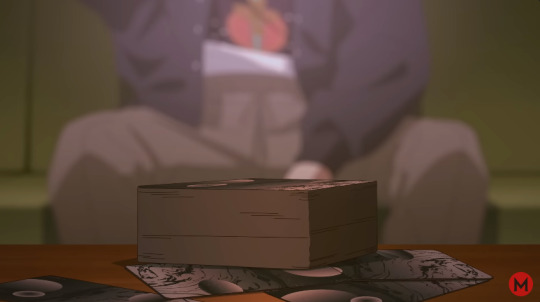

The first big connection between MeMe and the idea of destiny is obviously the recurring theme of tarot cards. These are used for divination, meaning the practice of trying to learn about the future through supernatural means. In other words, they're deeply tied to the concept of destiny, of future events that will come to affect us, and the ways we may influence it. What's important to take away here is that, regardless of whether or not you believe in it, reading tarot cards is a way for people to try to understand their future so they can take try to take control of it.
Once you make this little connection, a lot of the imagery in MeMe starts to get interesting. To give you an example, one of the opening shots is of a bunch of tarot cards all scattered in water.

So, their future is scattered, it's uncertain, it's messy, etc. You get the idea, I don't think I need to elaborate on why Mikoto's life is a bit of a mess.
However, I think there are two scenes which are particularly interesting in this regard. When Aokoto (host) draws a blank card in the first chorus, and when he gathers the cards in the deck at the start of the third chorus.

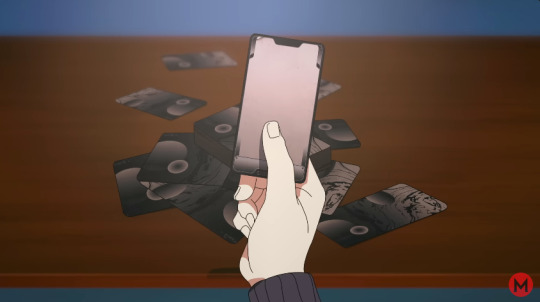

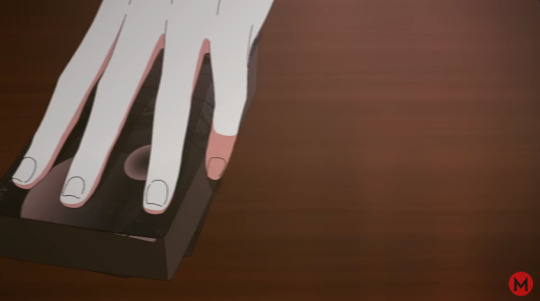
So first, we can be sure this is Aokoto because the lyrics not only use 'boku', but also express confusion at the situation, which only really fits the host.
Why am I [boku] here? It must be a mistake? Take a good look at me [boku], until you find me The truth will come to reveal itself I won't forgive you if this is happening to me even though I'm right
Why am I [boku] here? It must be a mistake? Take a good look at me [boku], until you find me
(Note: If there is no clarification on which pronoun is used when I put lyrics here, it's because the Japanese doesn't actually use any pronouns)
What's happening here? As stated, the tarot cards are a representation of destiny and their future. By drawing a tarot card, Aokoto is trying to understand his situation and destiny better. And by stacking the deck up neatly, he's trying to take control of his destiny, of his future. The desire to be free and be able to control his life is a very important part of Aokoto's character:
(T1) Q14: What will you be doing in 10 years? M (Ao): I'd like to work independently and make my own design company. That way I'm free to do what I want.
(T1) Q8: What are your reasons for wanting to work for your current job? M (Ao): I work at an advertising company that's at the top of the business world, you know? Just being able to get to that position is something to be proud of. I worked really hard to get hired there, too.
Aokoto places high value on the work he's done, because that shows how committed he is to having control over his life and his job.
(T1) Q12: How do you get to work? M (Ao): I ride a road bike. It's a hobby of mine, and it's good to exercise too. I don't need to worry about missing the train, but that can either be a good or bad thing.
I've seen this answer interpreted a few different ways, but personally I believe what Aokoto's implying is that the freedom of not having to rely on the train is both good and bad. Essentially, he doesn't have to stress about missing it, but there's also no guarantee that he'll get to work in time without the reliability of the train. However, he still prefers the bike, because it gives him more freedom.
... Foreshadowing is a narrative device-
There's also the matter of the tarot spreads which appear in that "blank card" scene. There are two distinct ones:


Now, the whole mess is too complicated to get into here (and I actually am holding off from analysis until we get extra context from Double for that reason), but I believe one of these spreads belongs to Aokoto, and the other belongs to Midokoto (Secret Third gatekeeper alter). Which is which doesn't matter, because the card I want to focus on is the card in the "Hopes and Fears" position (EXTREMELY long story), which is I - The Magician (upright) in both of them. The Magician represents (among a fuckton of other things because tarot cards are frustratingly ambiguous by design) power, potential, basically the ability to achieve your goals. Thus, in the "Hopes and Fears" position, it would mean Aokoto wants to be able to control his life and fulfill his potential, and is afraid he might not be able to.
There is also the "Present" or "Self" card being the reversed XII - The Hanged Man. The Hanged Man upright represents (among other things) patience, the hope that as long as everything continues the same, things will turn out okay. Thus, reversed, it could be read as implying the querent is trying their best to change their situation, but are failing at it.
And this is where we get to the second part of the scenes I pointed out before. Because when Aokoto draws a card by itself, it's a blank card. In other words, no matter how much he wants to, Aokoto doesn't have full control of his future. I mean, obviously, right? He himself can't control his destiny when the other alters are also doing pretty impactful stuff. Depending on what theories you subscribe to, he may have ended up in Milgram without even murdering anyone, which is what I believe.
The same can be seen when he tries to put the deck back together. You might notice the deck there is actually thinner than the other time we see it.


He tries to "fix" or "arrange" his future, but he's "playing with half a deck", he's only half in control of his future. In this metaphor, the other alter(s) would have the rest of the deck, would control the rest of the system's destiny. Does that make sense?
Which gets us to the other alter who does tarot reading.

Notice the red mannequin there? The way 0 - The Fool's pouch of food is now a skull? And you can see this alter, heavily implied to be Orekoto, reads a Celtic cross spread with the Fool in the "querent" or "present" position.
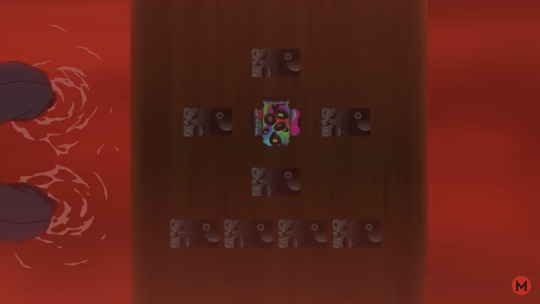
Thus, The Fool represents Orekoto, and he too desires control over their future. That's why he's reading the spread, the same way Aokoto previously tried to draw a card to check his future. And I think it's pretty safe to say Orekoto must have killed or attacked at least one person, which is his way of trying to secure a better future for the system. Protector alter and all that.
[Timelines] Mikoto (Ao): Can you hear me talking like this? If you can hear me, then answer me. Why are you doing such horrible things? Hey. It's your fault things have become like this. ……Answer me!! Mikoto (Ore): Ah, ahhh!! Because, I did it for my/your (Boku's) sake…! Because I/you (Boku-ga) would break apart!!
(Translation by Maristelina)
Plus all the other reasons to believe that.
That spread is a bit odd for many reasons, but one thing we can pretty much be sure of is Orekoto's "Hopes and Fears" are represented by VII - The Chariot.
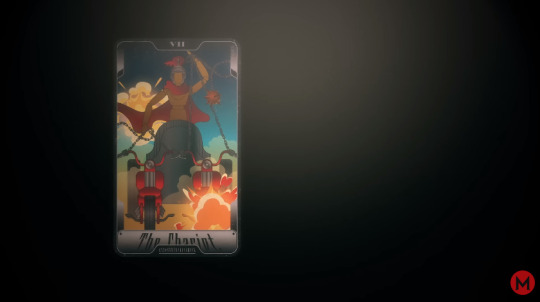
The Chariot (among other things) represents strength of will and control, basically think of it as a more forceful version of The Magician. Thus, Orekoto also hopes he can take control of their life, though he does it through force, and he fears he might be getting too forceful.
If I could laugh, if I could go back I'd play dead even though I'm alive right? If I could end, if I could stop How long would this dream go on?
Assuming it is Orekoto singing here (no pronouns so), it seems he doesn't want to kill, but sees himself cornered, like he has to kill. If he could stop, he'd "go back and play dead even while alive", he wouldn't kill anymore. But when he feels "boku will fall apart", he tries to save him through any means he can, which is likely murder. The exact reasons are as of yet unknown (someone stalking them, stress, could be a lot of things), but that's the idea.
However, you tarot enthusiast might notice a few interesting differences between this Chariot card and the actual Chariot card. This is important, because the meaning of these cards comes from the images, so when the image differs (apart from stylistic choices obvs), the meaning differs with it.

First important difference: the real Chariot has lions, MeMe's Chariot has bikes. This again relates bikes to the idea of freedom and one's own will.
Foreshadowing is-
Second; MeMe's Chariot has the protagonist swinging around a mace, which the real Chariot just has a wand. I frankly don't think this means anything other than MeMe's Chariot explicitly references murder rather than other, non-physical forms of strength and force.
Third, an important part of the real Chariot is that the man doesn't hold a leash on the lions, he controls them through force of will, apparently. Meanwhile, the mannequin in MeMe's version does hold chains to control the bikes, which again I believe simply implies a more forceful and direct version of the meaning. Orekoto doesn't trust his destiny to guide the system in the right direction as long as they're strong enough, he feels he needs to have more direct control.
And finally, the lions in the real Chariot are fine, but in MeMe's version, one of the bikes is fucking exploding.
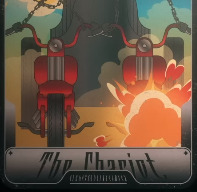
So what the hell is up with that? Well, let's keep in mind what I said before. Aokoto also wants control of his life. So I believe in a way these bikes represent Aokoto and Orekoto's actions. One of them Orekoto has direct control over (he controls his own actions, after all), while the other is getting hurt by Orekoto's control. Orekoto may want nothing more than to protect the system, but the way he does it is harmful to Aokoto and destroys the control he wants to have over their life. I mean, it landed them in Milgram (according to some interpretations), and it's not like Aokoto likes the murder.
(T1) Q6: Tell us what you hate. M (Ao): Staying up all night working / reptiles / violence
[Double Preview] Hey now, I [ore] saved you right? So why in the hell are you crying?
(I will use the preview as evidence, watch me)
Temporary CW for abusive relationships and rape (Mono Poisoner)
This idea of "love" that hurts the other is also implied by Mono Poisoner, their Trial 1 cover. Though to be clear, Orekoto is not anywhere near as awful as the protagonist of Mono Poisoner, since he isn't intentionally hurting the rest of the system, and obviously isn't actually abusing the other alter(s).
“She belongs completely, entirely to me!” Kissing, sleeping together, everything beyond that too No one can hope to cut this connection between us
After brandishing that poisonous desire to monopolize and having erased YOU completely, It seems like it can be easily embraced, the entirety of that heart “YOU best not get carried away!”
Taking out the really violent and abusive elements out, this does vaguely fit the idea I'm trying to get across.
Temporary CW over
Anyways, the point is that Orekoto wants control over their life, but is accidentally harming Aokoto by taking away his agency.
There is more symbolism of this ‘drive to control destiny’ in the moon which consistently appears throughout MeMe.
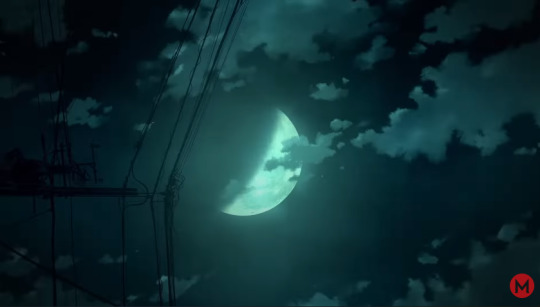

As you can see, it’s in the first quarter phase. This is halfway between the New Moon which represents the beginning of a journey and the Full Moon which represents the end or rebirth, and because of that, it can represent a difficult time where decisions must be made, a point where strength of will is necessary. This again fits both of Aokoto and Orekoto, since they’re both making important decisions for their future. Hence also why the moon is half and half, the future is being decided half by Aokoto, half by Orekoto.
Alternatively, you could read it as only Orekoto making decisions, with the other 'half' being "left in the dark" because Aokoto doesn't know what Ore's doing. That would explain why the moon only shows up in relation to Orekoto in the internal world and the murder scenes.
Heavy speculation incoming (more than before anyways)
But hold on a second. I said before the upright Hanged Man, the card on Mikoto's shirt through most of MeMe, is about patience and not doing anything to change their situation. This is somewhat contradictory to The Fool, which is all about new opportunities and taking new risks (long story), and is obviously contradictory to the reversed Hanged Man because that's how tarot cards work. Because of that, and everything else I've been saying, it feels like the upright Hanged Man doesn't really fit either Aokoto or Orekoto.
Which is why it's so convenient we have a third (plot-relevant, there may be more) alter who does want their life to continue as is, isn't it?
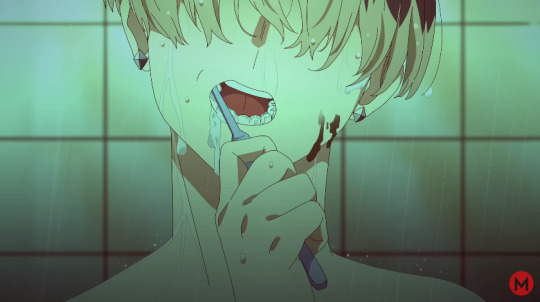
The minus energy that I swallowed Hugged me [boku] Maybe it's okay to try to keep on living Split in half, Make that heart beat
This scene is very clearly connected to the aftermath of a murder, and shows an alter that has accepted the "negative (minus) energy" of violence. However, the use of 'boku' rules out Orekoto as the singer. Thus, we have ourselves our favorite Secret Third Alter, Midokoto. And Midokoto says, filling in the blanks, that ‘maybe it’s okay to keep living [like this]’, as long as they ‘split in half’ to ‘make that heart beat.’
Before we continue, I have to address that yes, I believe Midokoto is represented by the upright Hanged Man, even though he’s the only alter who’s never seen wearing the shirt. Either his back is turned, he’s shirtless, or straight up has a completely different shirt. However, I actually think this makes perfect sense.
It’s widely accepted that if Midokoto exists, he’s likely a gatekeeper alter who co-fronts most of the time, meaning he’s still aware of everything that’s happening even while he isn’t controlling the body (<- simplified version, read more if you’re interested [alter roles] [co-fronting]). Therefore, he’s a constant in Mikoto’s life, and it makes sense for him to always be present in some way as long as any alter is on screen. He’s on the shirt when the other two are there, so when the shirt isn’t there, it’s because the ‘upright Hanged Man’ is the one controlling the body. Does that make sense?
I should note, Mikoto’s version of The Hanged Man includes a bunch of eyes on the background.
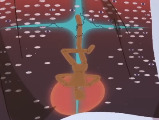
Which fits the idea of Midokoto overseeing everything in the others’ lives, and for the inverse in Aokoto’s case could also be interpreted as societal pressure, long story.
Yes, Midokoto's celtic cross spread has the reversed Hanged Man in the middle of The Wheel, but let’s just say that means ‘present’ rather than ‘querent.’ Yes, there’s a Fool portrait in the background of that one scene, I swear there’s an explanation but it’s too long to get into here.
Point is, he’s the one who wants their life to continue as is, and thus the one who fits the idea of ‘patience’ that The Hanged Man (upright) embodies.
But make no mistake. He still has The Magician as his “Hopes and Fears” in the spread which represents him, meaning he does yearn for some control and fears not having the means to achieve it.
However, I believe the type of control he’s looking for is different from the other two. See, while Aokoto wants freedom and control over his life in a more conventional way (good job, free movement, independence), and Orekoto wants control in a ‘no one will stop “I/you” from achieving what “I/you” want’ kinda way (aka safety), Midokoto wants control over the system, not the rest of their life. He wants to keep Aokoto and Orekoto ‘split in half’ because that’s how they can both live as they please, it ‘makes their heart beat.’
That’s why the moon that represents decision-making is split in half. That’s why there’s only two bikes in The Chariot card. That’s why Midokoto never bothers to read a single tarot card. Because the ones deciding where their life moves are Aokoto and Orekoto, all Midokoto does is keep things running smoothly. Though of course, this is all just my interpretation.
In fact, you can even tell based on what we believe each alter to do. Aokoto does the day-to-day work, making sure he has the opportunity to achieve his dream of working independently in the future. Orekoto deals with threats until the system as a whole is safe, which includes throwing away evidence so they don't get arrested. He does a dogshit job at it, yeah, but he's trying.
However, once they get into the apartment, when the external threats have been dealt with, the one who bathes to make sure Aokoto doesn't learn of Orekoto's actions, the one who keeps their lives metaphorically 'split in half', is Midokoto.
Heavy speculation kinda over
So, where were we? I said this was inspired by the Double thumbnail, didn’t I? Well, yes, even if I have very little to say about it in relation to this post. You could say I kinda, uh, went off the rails a bit (<- I am immensely unfunny)

As I said, he’s on a train. And with all the stuff I mentioned before about how bikes are associated with freedom for him and stuff, it makes the imagery of being stuck on a train with the victims (I assume that’s what the mannequins represent, I’ve seen other interpretations) a lot more interesting.
Think about it. When you get on a train, you made the decision to enter it, but you don’t have control over where it goes. And that’s what’s happening here: the alter on screen is in for the ride, and he feels there’s nothing he can do to alter the course. It’s like a railroad.
Aokoto didn’t get on this train. Obviously the scene is metaphorical (otherwise who left their mannequins in the goddamn public train), but we know Aokoto doesn’t use the train. However, he’s on it now, alongside Orekoto who is probably the one fronting here? I assume, given the red light in the background. In my mind it would make sense for the thumbnails to be Aokoto T1 -> Orekoto T2 -> Midokoto T3, but that doesn’t have to be the case.
What I’m trying to convey is the symbolism of the system being stuck in a set path, a set destiny, caused by a decision not made by Aokoto. And if Orekoto is really the one fronting or being represented here, he’s miserable because of the path his actions have landed him on.
If I could break it, if I could change Can I do it, I wonder from when I started to give up
He’s ‘given up’ because he’s accepted he’s ‘on the train’, his path is already set and he can’t change it (“if I could change”). Yes, give me that Orekoto angst!
Anyways, please keep in mind this is all my interpretation of the symbolism and all of this is extremely subjective, especially with how confusing Mikoto's entire story is. I hope you forgive my brainrot at seeing a guy take a train. Take care!
91 notes
·
View notes
Note
could you please elaborate that post about spiritual ennui not being the cause of many social phenomena? theres a whole book I started reading recently (work pray code) which is predicated on the idea that in the US work has come to replace religion as the centerpiece of peoples lives (simultaneously bc of a withdrawal from religion as a country and bc of capitalism demanding that life revolve around work) and I wasnt completely convinced by the authors evidence toward that hypothesis. or was the social phenomena in question more like online culture stuff?
i don't know that particular book or author, so i don't have a sustained critique of them. but in general, yes, i'm frustrated by hypotheses that basically boil down to the idea that a decline in religiosity and religious infrastructure is causing some kind of spiritual poverty that is in turn responsible for various social ills. commonly i see this argument used to 'explain' phenomena including: the persistence of astrology and occult sciences; gun violence; political 'polarisation'; drug use; perceived cultural decline; 'mental health crises'; &c. broadly these analyses tend to draw elements from max weber's idea of disenchantment,¹ a large-scale diagnosis of modernity's devaluation of religion, and from the related notion of desacralisation, the process of divesting individual objects or institutions of their divine properties or provenance.
i think these analyses are really fucking bad and here are some major reasons why:
they're not materialist. by this i mean that, instead of looking for material factors and conditions that might explain social and cultural phenomena, they turn to metaphysical, philosophical, and intellectual explanations. let's think about the persistence of astrology as an example here. on a disenchantment analysis, people are getting back into astrology because, having lost (organised) religiosity in their lives, they feel a spiritual void and seek to create new cosmological meaning through engagement with an anachronistic science-turned-spiritual practice. this explanation sucks. in addition to the fact that astrology and occult sciences never really 'went away' in the first place (& neither did religion lol), this explanation treats spiritual practice and belief as mostly an individual/psychological phenomenon, neglecting rigorous sociological attention to how these ideas spread and how group and community dynamics nurture them and form around them. it also ignores things like the profit motive for astrological practitioners, and related points about how heterodox sciences in general thrive in contexts where professional and class interests create a massive gap between laypeople and experts, barring the general population from accessing and engaging with scientific discourses and critique. 'disenchantment' also grafts onto a general idea about 'alienation', positing that the decline in religiosity creates a sense of loss and disconnect and that this psychological experience drives interest in practices like astrology. but when we talk about 'alienation' in a marxist sense,² we mean material conditions of production: the literal, physical alienation of a labourer from their products, and of a capitalist from the world (because they produce only proximately, via the labourer). the psychological experience of alienation is a result of this real material process of estrangement and expropriation; a weberian analysis that tries to put alienation down to cultural or intellectual factors is not useful for understanding material changes and the 'base' economic relations.
these types of 'disenchantment' analyses tend to claim or imply that they're making universal sociological arguments: religiosity decreases, x takes its place. but in fact these are highly culturally and historically specific arguments. weber's formulation was explicitly premised on a highly eurocentric and teleological conception of 'modernity' and modernisation, wherein the west led the world in a process of 'rationalisation' that involved jettisoning spirituality. that he was ambivalent about the consequences of this process does not make the argument any less flawed. for example, even defining religiosity is not so easy (do we measure by church attendance? private internal belief? community values?) and although the catholic church has become less powerful in certain ways since the reformation, a) it's hardly gone away and b) it doesn't follow that spirituality or religiosity writ large have declined. sticking with the astrology example, if the weberian explanation holds, we should be able to come up with some set of criteria for identifying societies with high or low degrees of religiosity, and then associate that with prevalence of astrological practice. but uh, both of these things vary widely between countries, regions, social groups, &c, almost as though there are other factors at play here, and 'religion' and 'astrology' themselves also have varying meanings, uses, and practical manifestations in varying social and historical contexts.
these 'disenchantment' explanations pretty much all start from the same rhetorical operation, which goes something like: "[x problem] is bad and harmful, which is discordant with my imagination of what 'the west'/the usa is 'supposed' to be like. why does such a [developed/modern/wealthy] society have these problems?" from there, it's a move to a critique of modernity/rationality/the speaker's notion of 'progress', and specifically a critique that aims to identify and root out some kind of spiritual rot or void, without ever challenging or problematising the construction of such notions of 'progress' or the processes of imperialism and colonialism that make 'the west' and wealthy lifestyles possible. in other words, these are generally reactionary arguments that seek to preserve the status quo of the material processes of exploitation and production, but want more psychological fulfillment for a few people.
these explanations are just really fucking bad and over-simplified explanations of how religion functions and what effects it has in a society. again, part of the issue here is that 'religion' is not even really a cohesive category and certainly not a unified set of practices. it works sometimes through institutions, which have their own financial and class characters; it interacts with and sometimes seeks to control politics; it also functions to enforce group identity and community cohesion. these are not inherently good or spiritually fulfilling things, and these effects all vary in different religions, societies, and historical contexts, which makes statements about the consequences of 'declining religiosity' kind of nonsensical on their face. religion can be a vector of racism, of caste, of other inequities; given astrology's essentialist character and resemblence to similarly class- and race-enforcing and -creating psychological projects, i'm certainly willing to entertain arguments that modern astrology performs these religious functions. but again, this argument would require actual materialist analysis, not just the vague diagnosis that 'people want to create spiritual meaning' in a 'modern' world supposedly too 'rational' to fulfill that need.
¹ term borrowed from schiller, but schiller used it somewhat differently and in a different context
² marx's later texts largely subsume the idea of 'alienation' or 'estrangement' into a larger analysis of 'commodity fetishism', which has its own theoretical problems in the construction of the 'fetish' concept; see j lorand matory's "the fetish revisited: marx, freud, and the gods black people make".
76 notes
·
View notes
Text
The Steps of being a RWBY Stan
Engaging with a dissident of RWBY wanting your words to come out of their mouths
Gloss over or outright ignore the dissidents thoughts and feelings and the reasons for their satisfaction and dissatisfaction
Reduce their arguments to whatever component makes them sound stupid, especially feelings, and label their arguments accordingly without elaborating
Tell dissidents to consume alternative you approve of, even if it doesn't have what they're looking for
Imply these people are not entitled to anything nor allowed to have a personal anything, and expect them to surrender every aspect of their autonomy to you, the "experts”
If they take matters into their own hands with either fanfiction or original works that recycles ideas and concepts, passive aggressively or patronizingly imply they're ultimately nothing and contribute nothing and these dissidents have no good reason for what makes them happy
Tell others to "curate" their consumption of media and interaction online, but never practice what you preach yourself, because you supposedly know better and need to correct and educate everyone
Inspired by this video
9 notes
·
View notes
Text
I don't think I get The Autobiography of Red by Anne Carson.
I didn't really know anything about this book going in. I bought it some time last year while on a quest to find Carson's Greek play translations. The summary looked interesting enough, and I was intrigued by the concept of a modern adaptation of Herakles's tenth labor.
Before reading it now, I tried to take a day to do a little research into the story of Geryon to prepare myself. I even looked at Stesichorus and what little is known about Geryoneis. I felt very prepared.
And... yeah. I still am not sure what's going on. I enjoyed the narrative and I loved Carson's lyricism, but I have no idea what it ultimately means. There's a depth of meaning in this novel, but it's too opaque for me to see.
Granted, I'm not really an expert in verse. As important as reading poetry is, it also always leaves me a little bewildered. For the first time in a long time, I wished I read this in school. At least them the professor would have supplied some pre-reading materials to review that would have informed my reading experience.
I did try to look up analyses on my own to help me parse through what I read. One paper I read (that I never wrote down the name of) elaborated a lot on the explorations of myth vs reality, which I found helpful. By and large the best article I read was from LitHub on the ways Carson utilized humor. That really helped me to figure out what Carson was doing with the sections about Stesichorus and Helen.
Even then, I'm still not sure where that leaves me. I've taken a few days to digest my thoughts, and I'm left with one lingering question: why Geryon? Why use this myth to tell this story? If I can just figure that out, I think everything else will fall into place for me.
That being said, I'm happy I read this. I didn't know this was a beloved piece of queer literature before I purchased it, and I was really happy to stumble into all these different accounts of queer readers finding truth in how Carson portrays coming of age, loneliness, and monstrosity.
This is a very special and important novel. I'll have to reread it someday and, hopefully then, I'll be able to take more from it than I did this time around.
--
The Autobiography of Red by Anne Carson
Rating: 4.5/5
14 notes
·
View notes
Text
Utopia K67
In his novel Blindness Jose Saramago narrate a story of a plague that affects the city so the encounters between inhabitants become increasingly frightening. The immense absurdity of the capital development of the contemporary city recalls Saramago's apocalyptic vision of the development affected by an epidemic of white blindness.

How will we live together when public spaces are sold out? The story is a parable of the fear of the unknown - is it war, isolation or just the fear of being to close to each other?
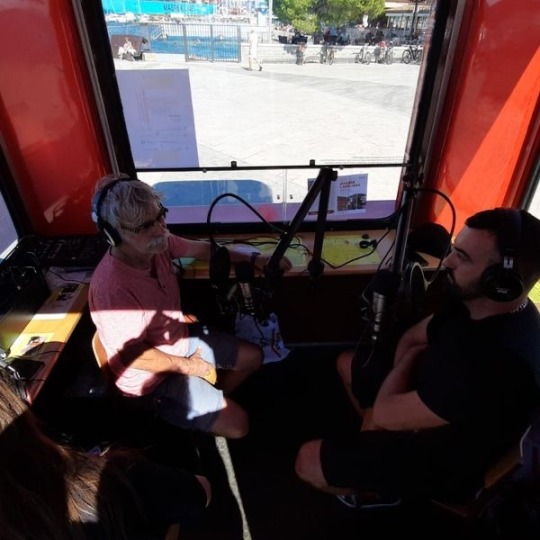

Public talks in K67 with local cultural and political figures transmitted live on-air of Independent Coastal Radio NOR.
The utopia starts in projects that are going beyond the expected rules. It points out the neuralgic problems of the location and seeks the analysis of the current state of matter. One of the utopias stands in a small Slovenian coastal town Koper - in a public square where a parking lot is situated on the most prominent position next to the sea.

The utopia - K67 kiosk, designed by Saša Mächtig in 1967, concludes its story with the absurdity of the use of the public square next to the sea in favor of parking. As the writer and journalist Martin Reichert, to whom we dedicated this project, would say, “it is a parking lot with the most beautiful view in the world."
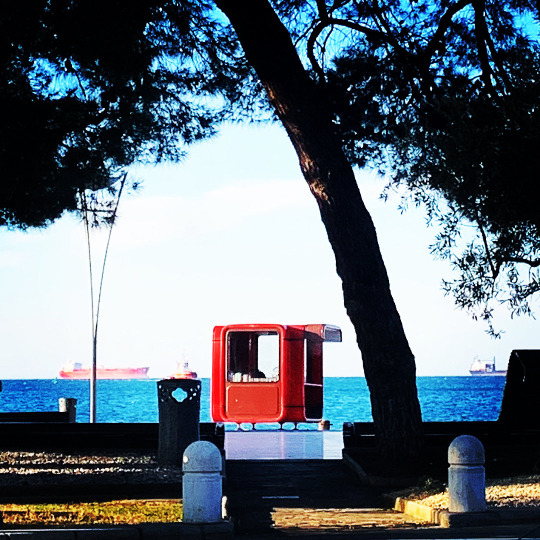
K67 is one of the best examples of design during the former Yugoslavia. In the context of the presentation in the public space, with the help of the owner Coastal Galleries Piran, it was placed on the square in Koper in December 2021, in order to become a new generator for its urban content.
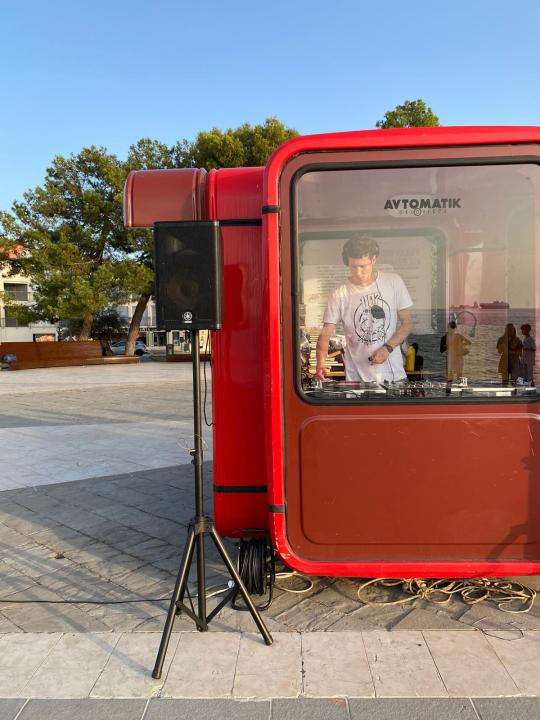


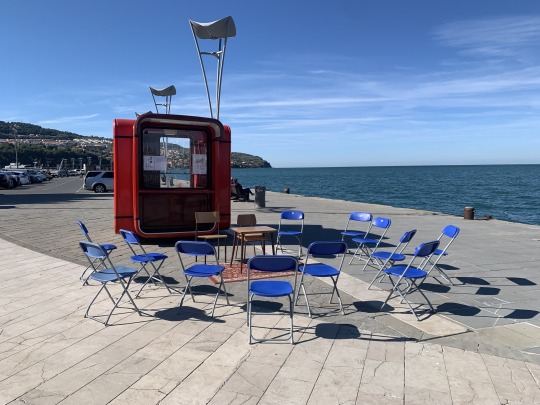
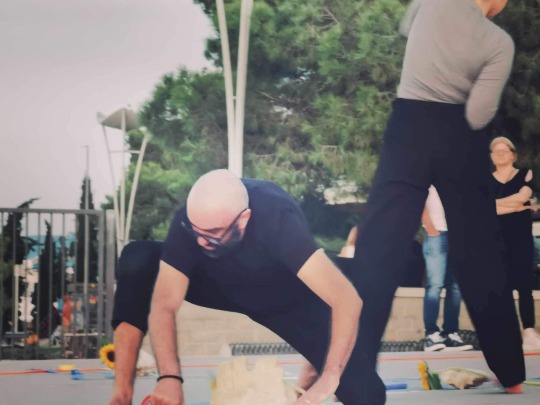
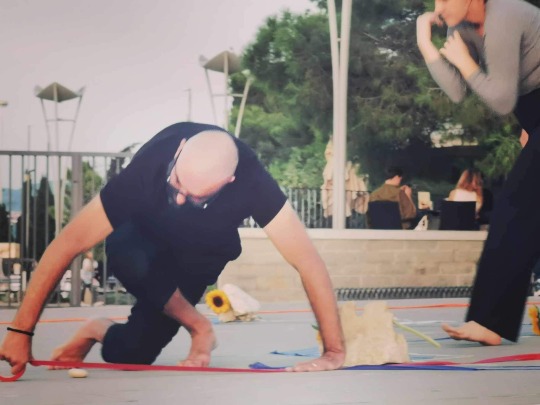
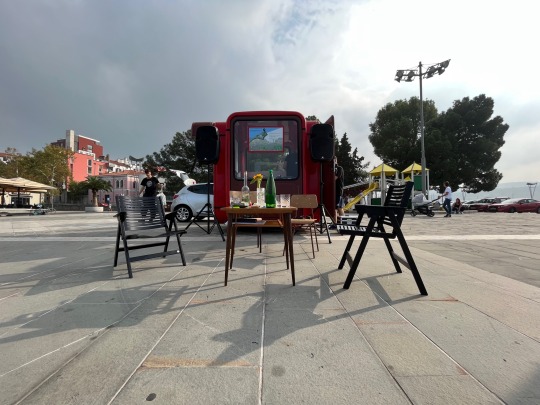
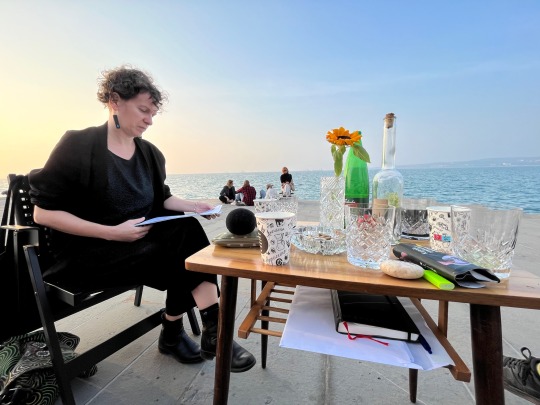


youtube
From spring to late autumn 2023, a process of tactical and performative urbanism took part in the K67 in favour to create an inclusive public space. The main concept proposed and elaborated within the municipality was based on the change of the current parking lot on the square into a green community space.

Unfinished project Solis was more than ten years a failure of a PPP concept. After COVID the investor succeeded to add two more floors of the private apartments.
Tactical urbanism is the opposite of investment urbanism, which has a dispersed structure of activity in space and builds various, mainly residential buildings that sell well, but without a well-thought-out placement in the context of the city. The last plan for Koper was signed by the architect Edo Mihevc in the 1960s.
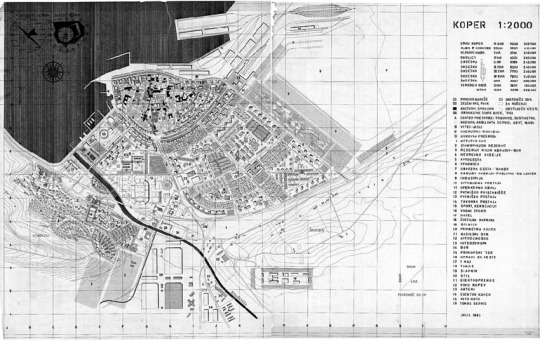
Urban Plan for Koper, Edo Mihevc (1961). | Source © Neža Čebron Lipovec
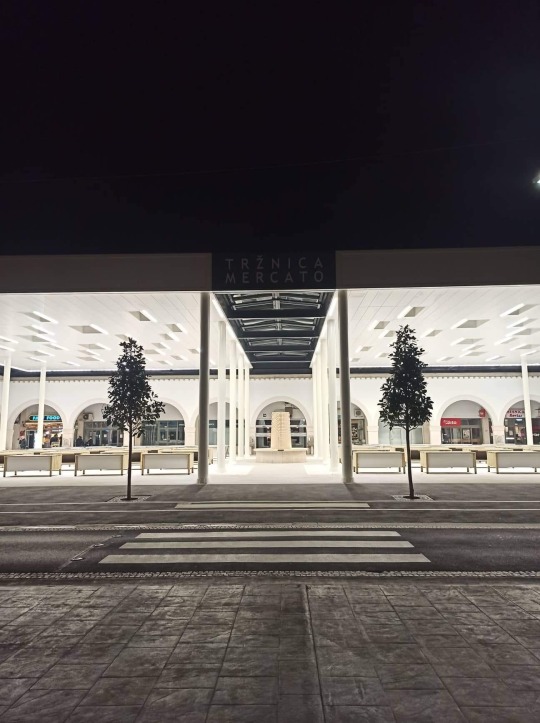
The renovation of the new roof for the city market was executed via the municipality but without a public competition.
Today it looks like investor urbanism is much faster than the concept of town planning per se. This results in a fact that there is no more urban planning in the city of Koper today.
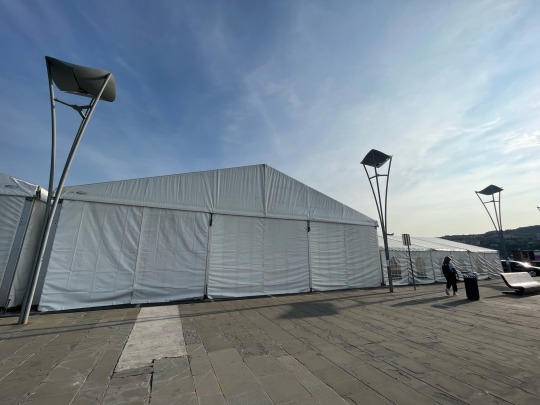


The farm market with live animals in plastic tent on Ukmarjev square shows the discrepancy of communication between the municipality and experts.
In Koper as in other towns across the Adriatic coast there is an obvious pressure from investor urbanism. Public spaces are mostly touristized, privatized and don’t belong to dwellers anymore. Therefore is important to ensure that buildings are not built without public competitions. The K67 stays a reminder of a utopia that shall make aware of the importance of reuse and creation of community spaces.
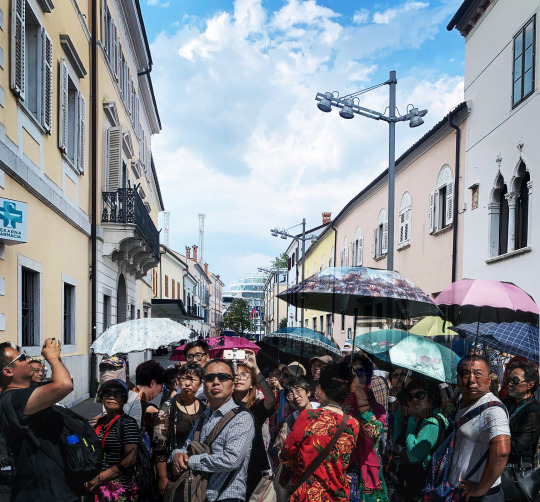
The cruise ships don't need to pay tax in Koper so instead of Venice, were are banned are welcomed for a pollution of cruise tourism.

The utopia K67 is dedicated to the writer and journalist Martin Reichert.
29 notes
·
View notes
Text
Let me tell you guys about the dream I had last night!
The first part took place in an old house in an old fancy neighborhood. At one point, we took a walk and looked at every house’s fancy gardens, which could get very elaborate. Cerebrum from Day Break Illusion was there for some reason, and he used his shapeshifting powers to make a false identity: a rich girl named Cera (pronounced like Sarah). Cera basically looked like Cerebrum but with a side ponytail and, y’know, feminine features. Come to think of it, wasn’t that Cerebrum’s disguise at some corporate gala in the actual anime? Idk, I watched the anime years ago and I don’t want to rewatch it because it really wasn’t good. I don’t really remember what Cerebrum was trying to accomplish with his Cera identity in the dream.
In another part of the dream, I was in a different country with my dad and this girl I used to go to school with. We were looking for a place to have lunch. We bought two slices of pizza to go, but then we immediately forgot about them and eventually went to an Indian place. It was weird, since the stuff on the menu was all unfamiliar, and everything seemed to be served with noodles instead of rice. I mean, I’m certainly not an expert on Indian food, but I’ve had it a lot in the past, and I didn’t recognize a single dish on the dream restaurant’s menu (except for the naan). The entree I remember most clearly was a “Japanese-style” curry with snap peas and honey roasted pork ribs. Yeah, I don’t know either.
The restaurant turned out to be a place where people could secretly write poetry, like an underground poetry club, because poetry was illegal in this country for some reason. I saw Tucker Carlson (eww) at the restaurant, and soon after that we decided to leave. There was more to the dream, including Disney merchandise and sneaking out through a garden gate, but I don’t really remember how it went.
Conclusion: dreams are weird, but maybe I’ll take the Cera concept, separate it from the Day Break Illusion context, and use it in a future story
5 notes
·
View notes